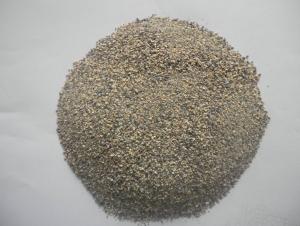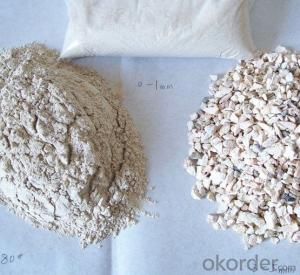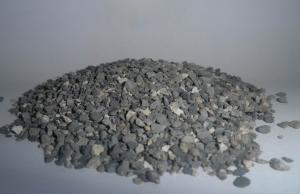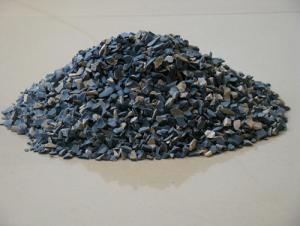Raw Materials for Refractory - Sintered Spinel Materials
- Loading Port:
- Tianjin
- Payment Terms:
- TT OR LC
- Min Order Qty:
- 20 m.t.
- Supply Capability:
- 1000 m.t./month
OKorder Service Pledge
OKorder Financial Service
You Might Also Like
It's made of industrial alumina and high purity caustic magnesia powder as raw materials. Sintered in super high temperature rotary kiln, characterized by big hardness , small coefficient of thermal expansion etc, it's ideal raw material of ladle castable and magnesia-spinel bricks.
Specification
Application
It's extensively applied to the lining of converter, glass kiln, open hearth, casting ladle etc.
In the same condition, using manganese or silicon to deoxidize separately, the burn out rate are 46% and 37%, but it is only 29% if using manganese alloy to deoxidize. So, it is used widely to smelting steel and its output increases faster than ferroalloy's, so has become an indispensable composite deoxidizing and alloy additives in steel industry. The silicon-manganese which contains carbon below 1.9% still is used to produce medium/low-carbon ferromanganese and semi-finished products of electro silicothermic process manganese metal.
- Q: What's the feature of construction external wall fireproof and thermal inuslation matertial?
- It has properties of low heat conductivity coefficient, low density, high flexibility, fireproof and waterproof. Its heat conductivity coefficient at normal temperature is 0.018W / (K · m) . The thermal insulation property is three to eight times that of the traditional materials. And it is completely waterproof. [2] Thermal insulation lining has properties of low heat conductivity coefficient, low density, high flexibility, fireproof and waterproof. Light, generally about10-96kg / m3, 20kg / m3 or less is felt, 24-48kg / m3 is middle-hard plate, 48-96kg / m3 is hard plate, wherein 48kg / m? can be used as ceiling, with softening point being 500 ° C , thermal insulation 300 ° C. It is widely used in the United States, k =0.9. Calcium silicate thermal insulation product is developed in 1970s in China. With high compressive?strength, low heat conductivity coefficient, recycle and easily construction, it is widely used in the power system. In China, small workshop?production were the most common, then four production lines were gradually introduced from America, including instant fiber forming, dry method punched felt, which are advanced and quality, temperature endurance up to 800-1250 ° C.
- Q: What is the best refractory company?
- Palladium activity is very rich ah, Sina micro-blog introduced a lot of jewelry related content, style is very unique, see people could not help but want to store to buy impulse.
- Q: What is the fire endurance of ceramsite concrete blocks?
- The heat conductivity coefficient of grade 800 hollow building blocks in ceramsite concrete is 0.23 and fire endurance is 4h. Ceramsite concrete has strong construction adaptability. It can not only compound concrete material with different unit weight and strength(It changes with the structure of thermal insulation or bearing structure) according to the different purposes and functions of buildings, but also is easy to construct. It is suitable for industrial production of a variety of construction methods. It can not only make all types of components(board, block, girder, column, etc) by using production process, but also can use mechanization construction of cast-in-place. The strong adaptability of construction of ceramsite concrete is not comparable to any other lightweight building materials(such as air-entrapping, etc.).
- Q: I want to consult the fire resistant level standards of external wall thermal insulation materials.
- 1, The thermal insulation material that has level A combustion performance: Spraying inorganic fiber, glass wool, foam glass, ceramic foam, rock wool, foam cement and perlite obturator, and so on. 2, The thermal insulation material that has level B1 combustion performance: Special processed extruded polystyrene board (XPS) / special processed polyurethane (PU), phenolic and polystyrene powder. 3, Thermal insulation materials that have level B2 combustion performance: Molded polystyrene board (EPS), extruded polystyrene board (XPS), polyurethane (PU), polyethylene (PE), etc. See article 4.3.6 in the 2009 edition construction technical measures. Level A insulation material is just for fire protection, so its thermal insulation performance is worse than the organic XPS or EPS materials. Hope this will help you.
- Q: What's the function of aluminium dihydrogen phosphate on the refractories?
- Mainly used for binder of high-temperature furnace refractory. Characteristics of liquid aluminum dihydrogen phosphate, castable. solid used for refractory spraying coating, chamotte, ceramic construction, which has high break resistance after being dried in 350-500 ° C, phosphate bricks. Characteristics of the solid aluminum dihydrogen phosphate, binding agent used for castable and casting industry: together with the refractory aggregate, ramming mixes at room temperature: Easy to mix, crush resistance, hydration resistance, chamotte, will not become soft even if soaked or boiling in water, molding. Liquid use refractory spraying coating, mainly used for corundum, chrome corundum water gap in refractory industry. The production of chrome aluminum zirconium corundum brick for water-coal-slurry gasifier is especially suitable for site construction applications mainly used for the electrical industry, high-temperature kiln and furnace, hardener, after mixing between 90-110 ° C for 4-24 hours at a constant temperature, forming strong bonding strength, electrical insulation, heat treatment resistance furnace
- Q: What is the use of refractory?
- It is equivalent to a protective layer. It can be used to protect structural materials from being direcctly attecked by high tempereture or internal gases. General structural materials are steel, so the main function is resistant to fire and high temperature. In literal meaning, refractory is a fireproof material. Steel is easily deformed and wore. Structural materials can not directly touched with solid and liquid. Refractory materials are generally used as a protective lining of structural material, so it is necessary to be protected.
- Q: Who knows about the grade C fireproof door materials?
- I am happy to answer your questions. Wood or steel materials are usually used. The new national standard fire doors: According to the enacted GB12955-2008, the fire endurance of grade C fire doors is 0.5 hours and that of grade A and B are 1.5 hours and 1.0 hours respectively. I hope my answer can help you.
- Q: What's the refractory material in common use currently?
- According to its category, raw material of basic refractory: Mainly magnesite (magnesia), dolomite, lime, olivine, serpentine, high alumina material (sometimes neutral); main neutral raw material: chromite, graphite, silicon carbide (artificial).
- Q: Who knows about the differences between 3M fireproofing materials and ShiLiDe materials?
- Advertising materials can be divided into fireproofing and non-fireproofing ones which can not tell the differences with naked eyes. You can ask 3M to provide test reports or go to a the third party test organization SGS to do flame retardant test, maybe I can help you. Mineral wool board is harmful to human body, will lead to chronic poisoning, the quality of it is bad! You must pay attention to it! It can not be used in chemical and pharmaceutical plants.
- Q: How to distinguish the fire resistant level of construction materials?
- Building materials fire resistant level is divided into four levels, among which the first level is the highest, with strongest fire resistance; fourth level is the lowest with weakest fire resistance. Fire resistance level of buildings depends on combustion performance and fire endurance of the building components. The building components refer to a series of basic components such as the building walls, foundations, beams, columns, floors, stairs, ceiling, etc.
Send your message to us
Raw Materials for Refractory - Sintered Spinel Materials
- Loading Port:
- Tianjin
- Payment Terms:
- TT OR LC
- Min Order Qty:
- 20 m.t.
- Supply Capability:
- 1000 m.t./month
OKorder Service Pledge
OKorder Financial Service
Similar products
Hot products
Hot Searches
Related keywords
























